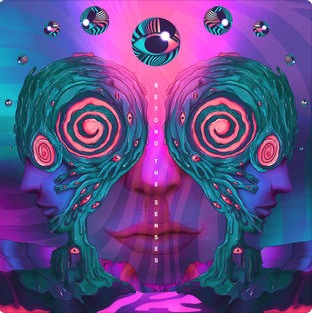Winter Devlog
Hello everyone! We’ve been quite busy for the last couple of months, but we have a lot to show off in this post, including:
- Scripting upgrades
- Renderer improvements and eye candy
- New asset bundler features
- In-repository documentation
Let’s get started.
Scripting
Thanks to a brand-new automatic code generation system, we’re able to easily
add more functionality to the scripting subsystem. Here, we’ve added bindings
to TransformComponent, and written a script to move around some point lights!
Mondradiko moving point lights
AssemblyScript
We now support writing scripts in AssemblyScript! AssemblyScript is a language based on TypeScript that targets WebAssembly, allowing for flexible and user-friendly scripting that doesn’t compromise on performance.
Here’s the AssemblyScript code used to animate the moving lights above:
import Transform from "./components/Transform.d";
export class SlidingLight {
speed: f64 = 3.0;
destination_a: f64 = -10.0;
destination_b: f64 = 10.0;
velocity: f64;
constructor() {
this.velocity = this.speed;
}
// TODO(marceline-cramer) ComponentScript component fetching
update(transform: Transform, dt: f64): void {
let x = transform.getX();
let y = transform.getY();
let z = transform.getZ();
if (x < this.destination_a) {
this.velocity = this.speed;
} else if (x > this.destination_b) {
this.velocity = -this.speed;
}
x += this.velocity * dt;
transform.setPosition(x, y, z);
}
}
The nitty-gritty details behind AssemblyScript are still being worked on, so expect the specific API demonstrated here to change, but hopefully this gives you a general idea as to how easy writing scripts for Mondradiko will be.
Windows Builds
Thanks to humbletim on GitHub, Mondradiko now builds and runs on Windows! We now rely on vcpkg for downloading and compiling dependencies, and building the entire project on any OS is now only a two-step process, dependencies included:
$ cmake -GNinja .. # Configure project and build dependencies
$ ninja # Compile
Although Mondradiko runs on Windows now, it’s not yet to the point where anyone other than project developers will find much of a use for it. Mondradiko is still very early in development, but at least we’ve ported it to Windows earlier rather than later. If you’re on Windows and want to tinker around or contribute to it though, now is the time!
Renderer Upgrades
The renderer has been massively improved since January, and it now features:
- Physically-based rendering (PBR)
- Normal mapping
- Depth prepass
- Masked texture
Screenshots

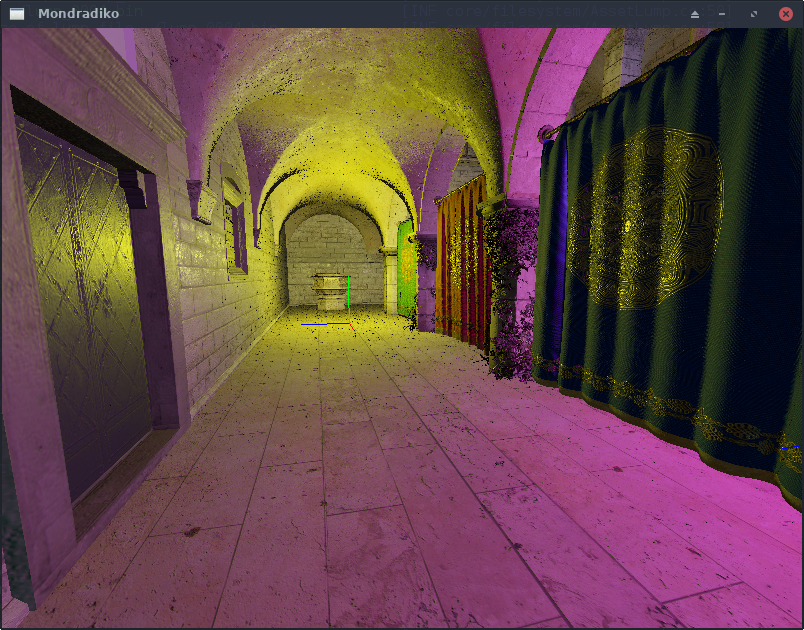
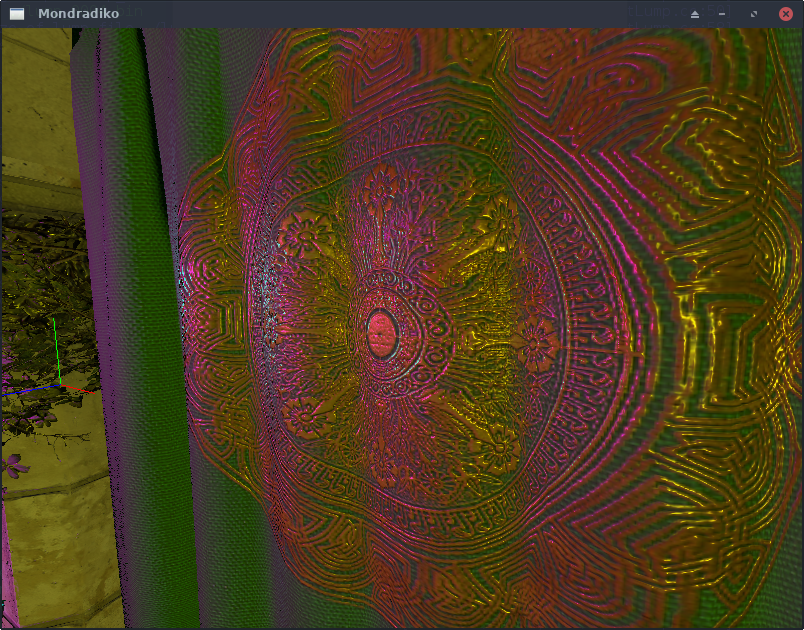
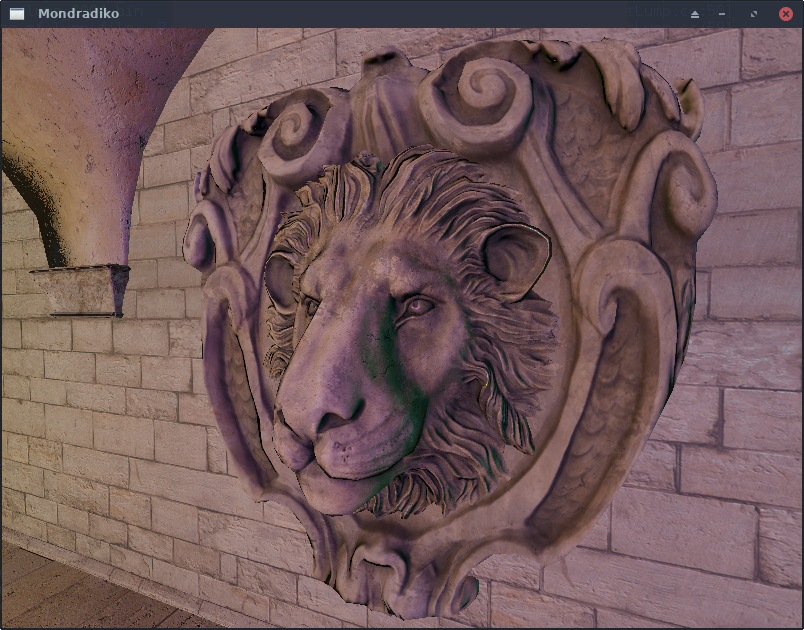
To-Do
The renderer doesn’t yet support materials that don’t supply a base color texture, but after support for materials without those textures is implemented, we’ll be able to load a much larger variety of scenes. Keep an eye out for even more eye candy!
The renderer also doesn’t support proper blended transparency yet. More on that in the section on glTF support.
There is also a distracting amount of aliasing in these screenshots. The aliasing is made worse when moving the camera around the scene. This can be resolved by adding trilinear filtering, anisotropic filtering, and multisampled anti-aliasing.
Bundler Improvements
Aliases
Assets can now be given string aliases that other assets and manual prefabs can reference:
[[assets]]
file = "scripts/SlidingLight.wat"
alias = "SlidingLight"
Manual Prefabs
Prefabs can also now be created in the bundler manifest manually, where before, the bundler was limited to using prefabs created from glTF models and their node hierarchies.
Here, for example, we’re creating a prefab that has a PointLightComponent to
emit light, a TransformComponent to position the light in the scene, and a
ScriptComponent bound to the script asset declared above to animate the
light’s transform.
[[prefabs]]
initial_prefab = true # Load this prefab when the world is created
[prefabs.point_light]
position = [0.0, 1.5, 0.0]
intensity = [100.0, 0.0, 100.0]
[prefabs.script]
script_asset = "SlidingLight"
[prefabs.transform]
position = [0.0, 0.0, 0.0]
Multithreaded Compression
The bundler now begins compressing and saving lumps to disk as soon as their size limit is reached. This is also done on an individual thread for every lump. These two things together MASSIVELY reduce bundling time, allowing for more rapid testing and content creation.
To-Do
- Dump command
- Bundle caching and dependency graph construction
- Manual prefab nesting
- Prefab glTF model children
- TOML-to-transform helpers
- Cameras for automated tests
glTF Support
The glTF converter has been patched since January, and now correctly loads glTF and VRM models!
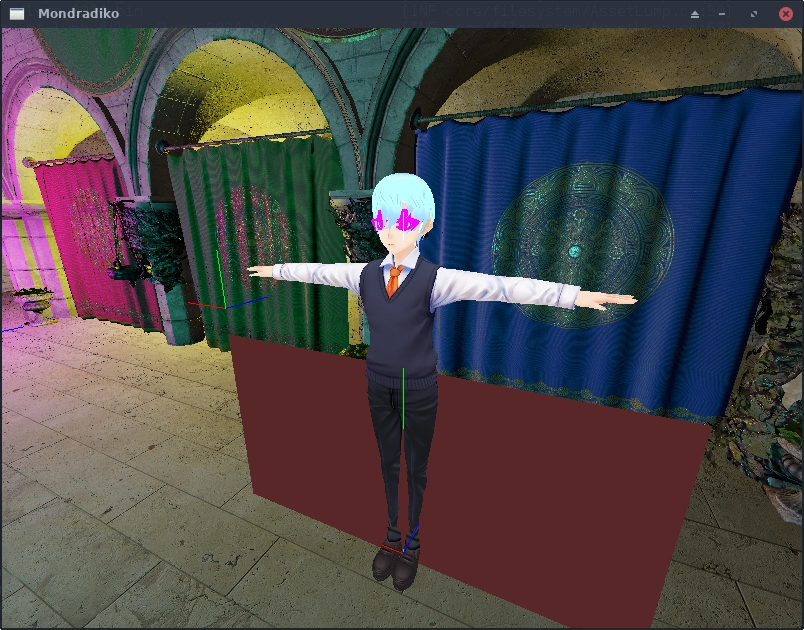
You’ll notice that there are what look like bright pink sunglasses on the VRM’s face. This is not the fault of the glTF loader, but of the renderer. Masked materials are drawing correctly, but alpha-blended materials are not, so the renderer inserts magenta where alpha-blended meshes are supposed to go, until proper transparency support can be implemented.
If the renderer is configured to skip drawing the pink stand-in meshes, you can see that the eyes are drawing correctly now too. However, the eyelashes and eyebrows are missing:
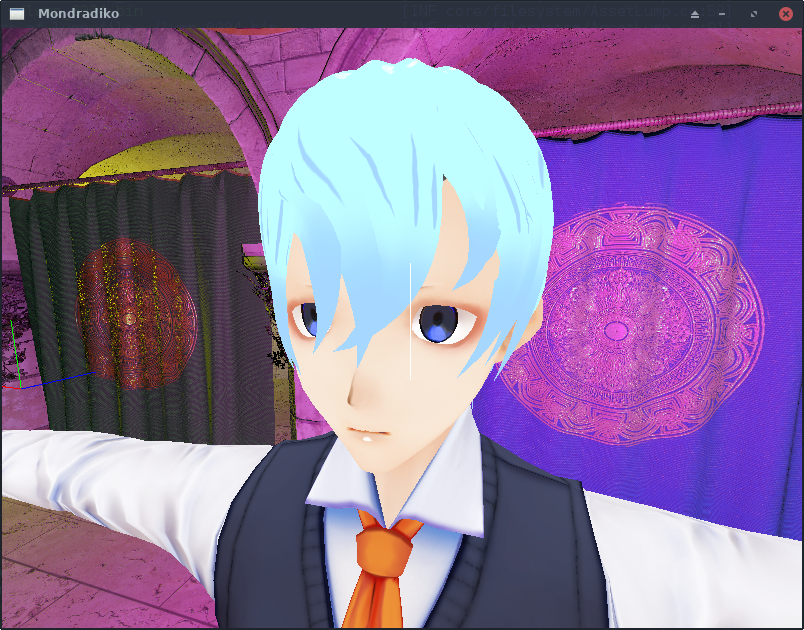
Little creepy.
There are still lots of things left to implement in the glTF specification, such as bones, weights, blend shapes, multiple texture coordinates, animations, and more primitive types, but the loader is coming along quite nicely so far.
Serverless Entrypoint
The Mondradiko client can now also run standalone (or serverless), meaning that testing out changes and content is much more convenient, as the server doesn’t have to be launched separately anymore:
# From:
$ server/mondradiko-server
$ client/mondradiko-client # In another terminal
# To:
$ client/mondradiko-client --serverless
Project Maintenance
As of the time of writing, there are around 17,000 lines of code in the repository, 12,000 of which are not empty or commented out. Mondradiko is beginning to become a pretty large project with several subsystems, including a scripting environment, a codegen system, and an asset management tool. Because of this, we’ve been putting a lot of effort this month into making the repository easier to work with, especially for new code contributors.
In-Repo Documentation
This month, I’ve been working on moving all of my thoughts and plans for the engine into markdown files in the code repository itself. This includes high-level overviews, diagrams, and explanations for each individual engine subsystem. This will make it easy for anyone wishing to contribute (or is just curious about the engine) to jump into the codebase and quickly learn how everything works.
This is being done in PR #18, which at the time of writing may still take a couple more weeks to be completed and merged. However, this is an essential step to making the engine easy to work with for programmers, and to growing it into a strong open-source project.
To-Do Lists
The in-repo documentation also includes comprehensive to-do lists for each subsystem. This will document what exactly needs done in each part of the engine and provide resources to help out completing those to-do items. Then, people wishing to contribute can pick out a to-do item (or several), work on them in a separate branch, then open a pull request. It will also be each contributor’s responsibility to update these to-do items and other documentation in their PRs.
Version 0.1.0 Release
Because of the ever-increasing size of the project, it’s been decided that we’ll be creating a version 0.1.0 release of the engine very soon! This is purely symbolic, but it represents how the majority of the foundation has been laid down, and how the major design points of the engine have been implemented.
Roadmap
Around the same time v0.1.0 is released, we’ll post another devlog post detailing a roadmap for this project. This will include goals, an overview of the engine’s design, plans for advertising and documenting development, and what state the project is expected to be in a year from now.
Miscellaneous To-Do
- Audio interface (AudioSourceComponent, OpenAL)
- World queries (tags, entity bounding boxes, BVH acceleration)
- ECS overhaul
- Entity relationships and hierarchies
- Resource caching (SDF atlases, GPU pipelines, JIT-compiled WebAssembly)
- User interface (simple demo, scriptable draw functions, basic hooks)
- More scripting (prefab instantiation, more component bindings, messages)
- Avatars (posable VRMs, controller tracking, inverse kinematics)
- Physics (Bullet integration, RigidBodyComponent, synchronization, bindings)
Opportunities for Contribution
Suggestions
Any ideas or suggestions for Mondradiko are welcome! Please join our Discord server, where I and the other developers are active, and drop any thoughts you have. As a potential future user, your opinions are important.
Documentation
There’s a lot of documentation being currently written, and any feedback is appreciated, as the people reading this devlog post now are likely the people who are going to be relying on this documentation in the future.
Funding
If you’d like to help support the development of Mondradiko, please become our patron on Patreon! A large part of Mondradiko’s development relies on cloud services to function, such as automated builds, testing, and packaging, along with hosting the world servers themselves. The money also goes towards buying a larger variety of VR hardware to test on and develop for. Anything helps!
Programming
If you have any coding experience, either from making games in Unreal Engine or Unity, or low-level C++ programming, we need your help! Please join the Discord server to get in touch with the project maintainers and discuss the work needing to be done.
